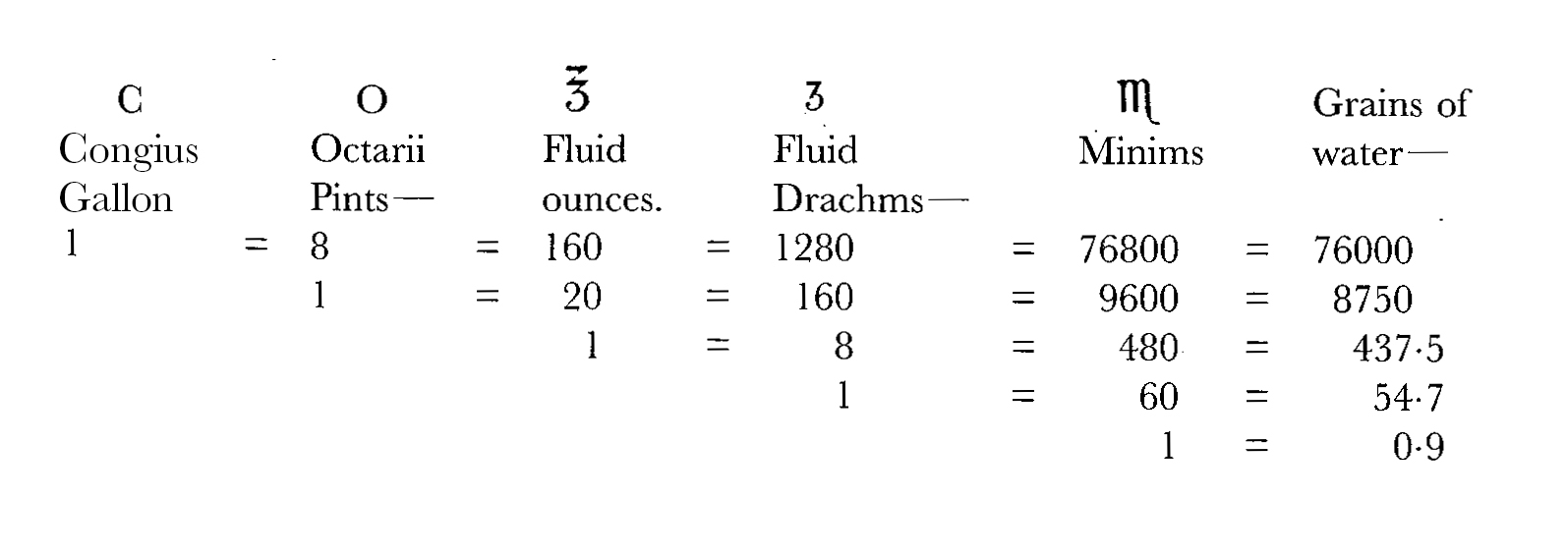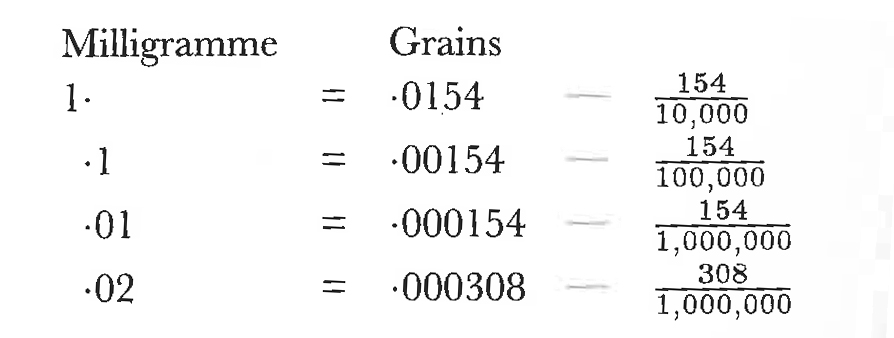From Edward Cresy 10 November 1860
1 Greek St—
10 Nov ’60—
My dear Sir,
The discrepancy in regard to the weights & measures I think admits of explanation—1 Previously to 1836 the old Wine measure was in use and served as the basis of the fluid apothecaries measure in this wise— The gallon or congius was the unit this was divided into 8 parts octarii or pints— each of which was considered roughly to weigh a pound— in point of fact it weighed 7289.7 grains a pound avoirdupois is 7000 grains— well then this old wine pint thus roughly assimilated to a pound was divided into 16 fluid ounces—&c thus—

Subsequently to 1836 the new measure came into operation by which the pint in lieu of containing 28.875 cubic inches was made to hold 34.659 cubic inches to meet this change the apothecaries subdivided the new pint into 20 fluid ounces instead of 16— still retaining the old subdivision into drams scruples & minims but their weights became materially altered— the old fluid ounce contained 455.6 grains of distilled water the new contains 437.5— the old fluid drachm contained 56.9 grains, the new 54.7 grains— I dont know whether you have the subjoined table but it is a very useful one—

It is convenient if you have not a measuring glass to weigh out your measure with a pair of scales in fact it is more accurate for the glasses are often very indifferently graduated only of course you must not consider a very heavy or very light liquid weighs the same per gallon or per pint as water— a gallon of ether weighs 7 lbs. a gallon of nitric acid 15 lbs—
I have called on Hofman2 and had from the explanation he gave me written to you that his note was quite correct but having penned the passage I checked the figures from the data he gave me and found they did not work out rightly so I cancelled a page and called again this morning at the College of Chemistry and saw his Secretary,3 as it was merely a matter of figures I would not trouble the Dr. and the Sec confirmed my summing— The original solution was made by dissolving 10 milligrammes of iodine in 1000 grammes of water—that is one to one million— the Dr then took one gramme of the solution containing therefore .01 milligramme that is of a milligramme, & he found no effect, he then experimented on two grammes of the same solution containing two hundredths of a milligramme with a sensible result— The strength of the solution remained the same in both experiments but the absolute quantity of iodine present was double in the second— He was kind enough to call in his assistant who made the solution that I might question him and both he and the Dr agreed as to the quantities originally employed, but these quantities when I got home I found did not give the same decimals as the Dr’s letter—4 he gives 0.001 or one thousandth of a milligramme per gramme. I find 10 milligrammes per 1000 grammes = 1 kilogramme = 1 litre—gives .01 per gramme and in this the Sec says I am right well then.

So that in the Dr’s second experiment he discovered by the starch test 308 millionths of a grain or 3 ten thousandths or which is credible enough as compared with Alfred Taylor’s statement of the visibility of grain of arsenic—5 the Dr’s error is in having one place of decimals too many—a very likely one and the plague of the decimal system you know you ought to write a milligramme .001 then the Drs .01 becomes .00001 a very clumsy figure to work with—6 This explanation will I trust prove satisfactory notwithstanding its interminable length which I have run into mindful of the maxim brevis esse laboro, obscurus fio—
While writing Woodward Brit Mus—came in and I always like to stir him up about the Origin,7 “Ah he says it is a very sad book, it unsettles all one’s religious principles and the worst of it is so much of it is true— It is just like all those Geologists they say they dont know whether God made the world or the Devil and it is my opinion they dont care!” He says Owen is a worse materialist than you are—8 What a dreadful man he must be!—
I delayed answering till I could see Hofman— pray write if I can do anything more for you—
Yours most truly | E Cresy.
I sincerely trust from your not mentioning your daughter that she is rapidly amending— Pray present our best respects to Mrs Darwin and expression of our very earnest sympathy for the anxious time you must have passed—
C Darwin Esq—
CD annotations
First CD note:910
Look out for weight of fluids.
1/28,800 of gr437.50?
of of [rain` del] 1 grain
[‘Money’ del] Weight & Measures | [illeg] Notes & Book. Look to references in other works about segregation. One of my minute drops from Pins Head is 1/28,800 of oz in bulk & ... 1/28,800 of gr437.5, which is weight of 1 oz of water. [amp; [illeg]f oz` del] One minim *of water [interl]weighs of gr. (according to Cresy) & (or my minute drop weighs of of gr. i.e. or of a grain. This is the result gained by taking 1/28,800 of 2 oz, or quite accurately .015191.
Second CD note:910
The original solution contained 10 milligrammes of iodine in 1 kilogramme of water. i.e. .01 milligramme per gramme.
[diag]
The original solution was 1 part of iodine in 1,000,000 parts of water, and in this grains were not discernible, but were.
Footnotes
Bibliography
Correspondence: The correspondence of Charles Darwin. Edited by Frederick Burkhardt et al. 29 vols to date. Cambridge: Cambridge University Press. 1985–.
Origin: On the origin of species by means of natural selection, or the preservation of favoured races in the struggle for life. By Charles Darwin. London: John Murray. 1859.
Taylor, Alfred Swaine. 1860. Facts and fallacies connected with the research for arsenic and antimony; with suggestions for a method of separating these poisons from organic matter. Guy’s Hospital Reports 3d ser. 6: 201–65.
Summary
Explains discrepancies in weights and measures caused by changes since 1836 in apothecaries’ measures.
EC has found that a discrepancy in A. W. von Hofmann’s experiments with iodine solutions resulted from an error in Hofmann’s use of decimals.
Reports S. P. Woodward’s opinion of the Origin: "a very sad book, it unsettles all one’s religious principles and the worst of it is so much of it is true".
Letter details
- Letter no.
- DCP-LETT-2980
- From
- Edward Cresy, Jr
- To
- Charles Robert Darwin
- Sent from
- Metropolitan Board of Works
- Source of text
- DAR 58.1: 7, 9
- Physical description
- ALS 4pp †, CD note
Please cite as
Darwin Correspondence Project, “Letter no. 2980,” accessed on 12 November 2024, https://www.darwinproject.ac.uk/letter/?docId=letters/DCP-LETT-2980.xml
Also published in The Correspondence of Charles Darwin, vol. 8


